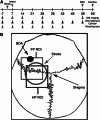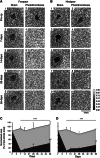Multimodal examination of structural and functional remapping in the mouse photothrombotic stroke model
- PMID: 23385201
- PMCID: PMC3652691
- DOI: 10.1038/jcbfm.2013.7
Multimodal examination of structural and functional remapping in the mouse photothrombotic stroke model
Erratum in
-
Corrigendum.J Cereb Blood Flow Metab. 2017 Oct;37(10):3457. doi: 10.1177/0271678X17726949. Epub 2017 Aug 8. J Cereb Blood Flow Metab. 2017. PMID: 28786737 Free PMC article. No abstract available.
Abstract
Recent studies show a limited capacity for neural repair after stroke, which includes remapping of sensorimotor functions and sprouting of new connections. However, physiologic and connectional plasticity of sensory maps during long-term functional recovery in the mouse have not been determined. Using a photothrombotic stroke model, we targeted the motor cortex, which we show results in lasting behavioral deficits on the grid-walking and in the cylinder tasks out to 8 weeks after stroke. Mice recovered performance in a skilled reaching task, showing no deficit from week 2 after stroke. Long-term optical intrinsic signal imaging revealed functional reorganization of sensory cortical maps for both forelimb and hindlimb, with more diffuse sensory physiologic maps. There was a small but significant increase in motor neuron projections within the areas of functional cortical reorganization as assessed using the neuroanatomic tracer biotinylated dextran amine. These findings show that the sensorimotor cortex undergoes remapping of cortical functions and axonal sprouting within the same regions during recovery after stroke. This suggests a linked structural and physiologic plasticity underlying recovery. Combined long-term structural and functional mapping after stroke in the mouse is practical and provides a rich data set for mechanistic analysis of stroke recovery.
Figures






References
-
- Calautti C, Baron JC. Functional neuroimaging studies of motor recovery after stroke in adults: a review. Stroke. 2003;34:1553–1566. - PubMed
-
- Cramer SC. Repairing the human brain after stroke: I. Mechanisms of spontaneous recovery. Ann Neurol. 2008;63:272–287. - PubMed
-
- Brown CE, Aminoltejari K, Erb H, Winship IR, Murphy TH. In vivo voltage-sensitive dye imaging in adult mice reveals that somatosensory maps lost to stroke are replaced over weeks by new structural and functional circuits with prolonged modes of activation within both the peri-infarct zone and distant sites. J Neurosci. 2009;29:1719–1734. - PMC - PubMed
Publication types
MeSH terms
Grants and funding
LinkOut - more resources
Full Text Sources
Other Literature Sources
Medical

